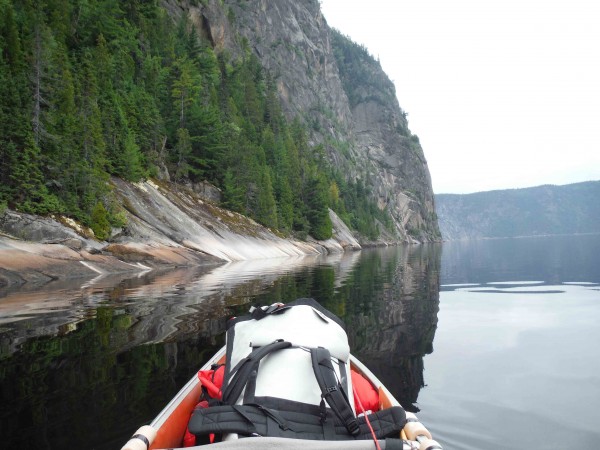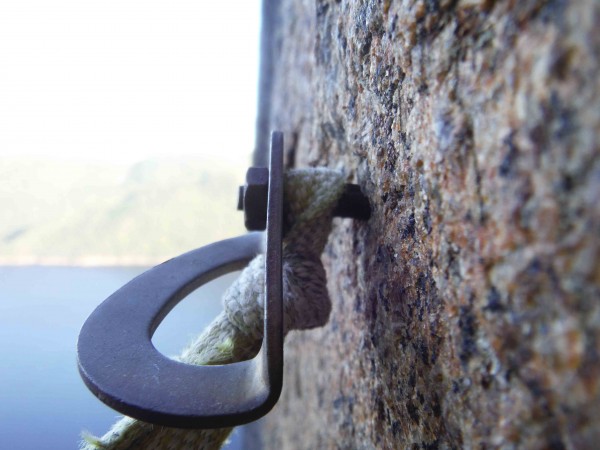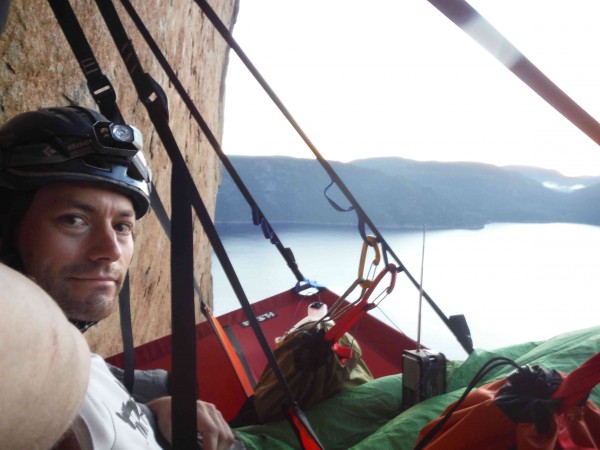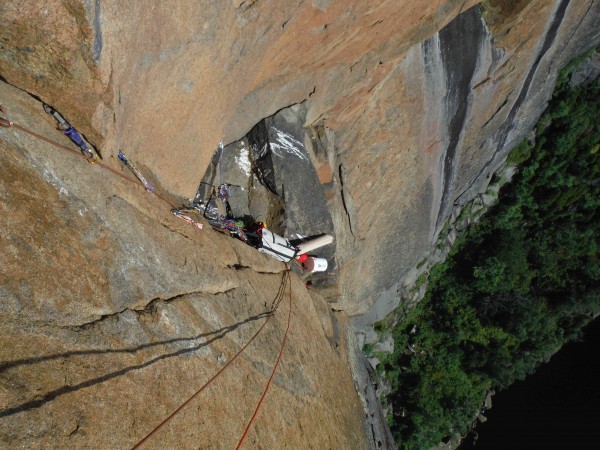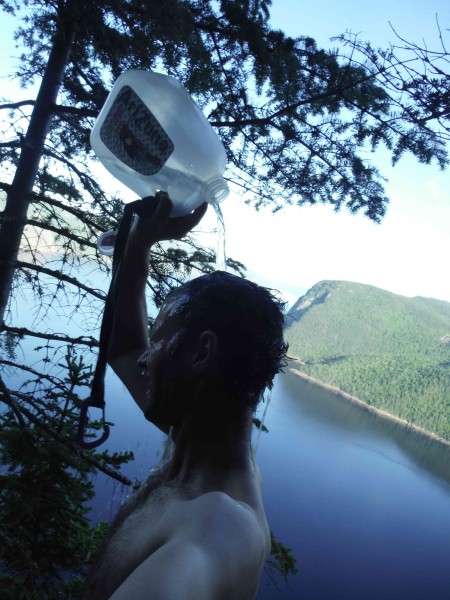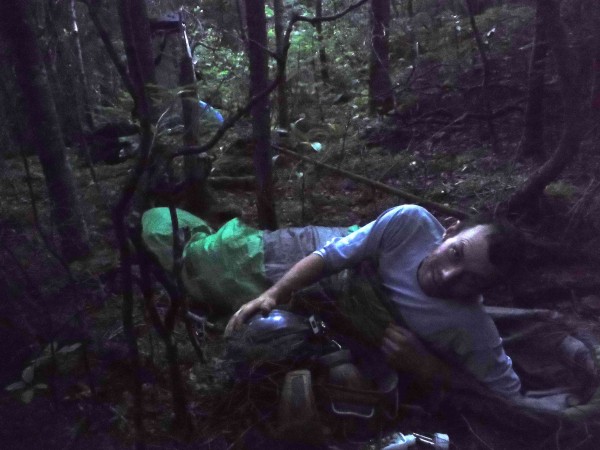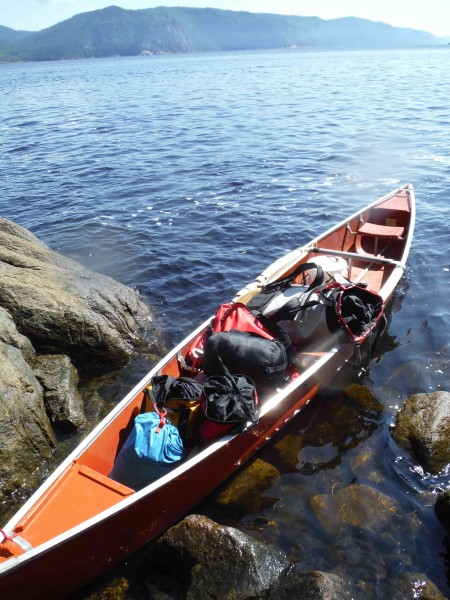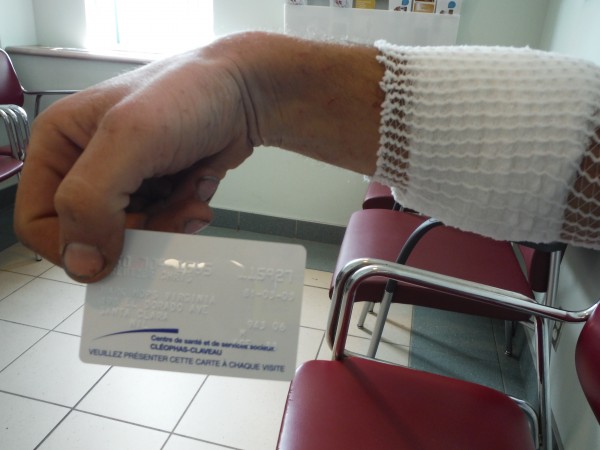My first challenge was to find a partner, I never had a climbing mentor, in fact I often never had a climbing partner. Having to work weekends most of my life to pay for school forced me to explore the lonely endeavor of rope soloing. Fortunately, in recent years I have found one fairly reliable climbing partner, Mike. His primary passion is ice and mixed rock and ice climbing, but occasionally he will get out on the rock in the summer with me. We discussed the idea of a big wall climb of Les Grands Galets at the end of this year's ice season and decided on a time line for training. Unfortunately, about eight weeks out from our trip Mike began to back out of our training weekends leaving me hanging. Not having a car and stranded in Boston I was only able to practice aid climbing while top rope soloing at crags that were accessible by the subway. After the third weekend in a row of backing out, he pulled the plug on the trip entirely. Having already bought myself a haul bag, haul line, portaledge and all the basic aid gear and knowing that after this summer I would no longer be living in the North East, and might never have the chance to climb on Cap Trinity again, I set out to find a new partner. Out of the handful of people I asked, only one showed any interest, Ashley. She had been climbing for about 6 months and I showed her how to make a top rope anchor a few months ago. While not the most promising candidate for a wall climbing partner, she was eager to learn and she had a car! Unfortunately, after showing up 2 hours late to the local crag for our first day of practice she lowered me off the top of an aid pitch, looked at my cam hooks and ball nuts and said "I can't do this trip, I don't even know what half of that climbing gear is."
Not willing to give up on my dream after feeling I had come so far, I decided to make this a solo trip. This was not a foreign idea. I had been rope soloing about as long as I had been climbing. One of my first trad leads, Monday Morning Slab Right on Glacier Point Apron I did while rope soloing and my first time leading ice was while rope soloing. The rope soloing was only the first of a few new barriers I had to deal with if this trip were to happen. I had no car and was now out half an aid rack. Thank God for Craig's List and eBay. I was able to find a deal on another 25 used cams and a few more sets of nuts on eBay. As for the car, I decided renting a car was too expensive, so I bought the cheapest car I could find on Craigslist, $460, with the idea of selling it after the trip to get my money back (I sold it for $800). It came with the exhaust system in the back seat and would not pass state inspection, so I had to buy a MIG welder, also from Craigslist, and weld up a new exhaust system. I also had to change all the brakes and tires. Because of all the car repairs, I was unable to get out and practice on the weekends so instead of practical experience leading aid pitches I ordered and read every book on big wall climbing I could find on Amazon; there were only five.
The final hurtle was to get permission from the park service in Quebec to do the climb. This turned out to be much harder than expected due to their disorganized system and fear of having another climbing related death on their hands. In 2003 an inexperienced couple incorrectly rigged their portaledge and fell to their death. After spending a week calling and e-mailing them I had gotten nowhere. Finally I was put me in touch with a park ranger by the name of Graham who spoke English. Five days before I planned to depart on the trip, Graham e-mailed me three liability forms and a request for a detailed itinerary of my proposed trip and told me to get the documents back to him right away as the director of the park will need to review them and decide if I can do the climb. I spent the remainder of that week more stressed and agitated than I would like to admit. I had planned to leave on Saturday morning and it was not until Friday morning that I got an e-mail from the park. Having spent more money, time and effort on this trip than I could have possibly imagined when I started this whole thing I was stressed out to no end realizing it all hinged on a single e-mail. I nervously opened it. To my relief the trip was a go, I had my wilderness permit approved.
After strapping a borrowed canoe on top of my car with a homemade roof rack consisting of four pool noodles, a roll of duct tape and some cord, I spent that Saturday driving up to the Saguenay River. On the way up I stopped at a tourist information center and was given a number of visitor information handouts on local attractions. That night before sleeping in the car, just outside of the park, I looked through the handouts and found an aerial photo taken of Cap Trinity that showed the route I was going to climb and all the various cliff bands. I had already committed to the idea of a walk off and thought this aerial photo might be useful so I took a photo of it with my digital camera, so I could reference it later if I needed.
The following morning after the 45 minute paddle out to Cap Trinity I dragged the canoe out of the water and into the bushes. I began carrying loads of gear up from the water to the base of the climb. It was one of the most exciting moments of the trip. Not only did I have close to a thousand feet of vertical rock looming over my head, but the trail to the base was a real bushwhack. I felt like I was on some big name sponsored expedition into the unknown. That day I was able to fix the first two pitches. Most people would probably spend the night on the ground, but I was so excited about the idea of sleeping on the wall I decided to haul my gear that day and spend the night on the portaledge. Unfortunately, hauling was fraught with difficulty. I got the haul bag stuck three times between rock overhangs and trees growing out of the base of the cliff. With no partner to tend to this from below I had to fix a life, rap, unstick the bag and jug all the way back up three times. I spent that night only one pitch off the ground, but I was still having a blast. Sleeping on the wall was also the dryer option. There were intermittent rain showers all day and evening, but the wind was strong and blowing from the other side of the cliff which kept me free of rain. I was able to sit back and enjoy the rainbows and watch the showers pass by without ever getting a drop on me.
The following day the hauling became easier. The bag only got stuck once, maybe twice. I found it a little unnerving to be dangling by a single fixed line 60 or 70 feet below the anchor in space trying to reach the stuck haul bag or cleaning my gear. The exposure was more than I was accustomed to and at that point I still had a few more days of it with the hardest climbing still ahead and I did not know how hard the climbing was to get. There was not much written about the route. I had gotten most of my route beta from watching a few YouTube videos and I found a few hard to read topos on-line. I had seen grades of 5.13 or .14 completely free to 5.10 C2 to 5.8 A3. The uncertainty, exposure and lack of a partner started to get to me mentally. Some how mid-day that second day my mind went numb. With the exception of a few brief moments during the rest of the climb, fear, concern, nervousness were more or less non-existent. I consciously tried to block these feelings out and to meet every obstacle with an emotionless "let's see if this will work" approach. Also on day two of this climb I started to realize that this route does not get much traffic. I encountered more cobwebs and plants in the cracks where I needed to place gear than I had ever before. Frequently I had to pull grass out of the cracks so I could visually assess the quality of my gear placement. Oddly enough, about the time I was realizing how little traffic this route gets I saw two more climbers show up in a canoe. I exchanged a few words with them and they told me they were going to climb the same route as I, but planed to rappel down as the walk off is difficult to find. That day they fixed the first pitch and spent the night on the ground in a tent.
The third day I found myself leading the hardest, most dicey aid I had ever been on. I found pitch six to be the crux. The rock quality was the worst. I found myself going 4 or 5 gear placements before getting one that I thought might hold a fall. There was evidence of an old bolt later, but many of the bolts were missing, by the looks of some that were remaining, I presume the missing ones fell out due to the erosion of the rock. It was when working through this crux section I instinctively flagged my right foot out to the side when stepping up in my aider. As I did this I tapped a block about the size of a gallon of milk (it did not look loose) and sent it free. I began shouting "ROCK!" As loud as I could to the climbers below me. For a moment I thought the block was going to clear the whole cliff, but I was wrong. It hit the start of the second pitch and exploded like a bomb not far off from one of the other climbers.
The following morning I woke to see the other climbing party paddling away in their canoe. On this day the sky was without a cloud. The sun was warm and the rock glowed an amazing orange at sunrise. I had two pitches left before topping out. Both pitches traversed to the left around a roof so I decided to fix both pitches before lowering out the haul bag. This way, if I got stuck on the last pitch I could down aid back to the last of the vertical pitches and easily rappel back to the ground without having to deal with down aiding with the haul bag. By mid-afternoon I had topped out, finished hauling and cleaning gear. I felt as though I had aged ten years, but was elated. I had pushed through more barriers and obstacles, both of the climbing and non-climbing kind to bag my first wall climb and I did it solo.
Due to the unexpectedly cool weather at the start of the trip, I had two gallons of water remaining. I decided to celebrate by taking a victory shower with one of them. After, I packed the haul bag with the remaining food, cloths, sleeping bag, empty water jugs and half a gallon of water. I left all the climbing gear and a half gallon of water at the top. I set out to find the way down with a plan to return the following morning to retrieve the climbing gear.
Initially the trail was obvious as there was a fixed line to follow along the edge of the cliff. But after some time of following an increasingly vague trail, I found myself sinking into a bog up to my shins trying not to lose a shoe. I was far from any established trail and the sun was getting low. Feeling frustrated and anxious to get down I decided to just bushwhack my way down. Unfortunately, this led me to one drop off after another and eventually I realized I was completely lost and only had a few more minutes of daylight. As the sun went down that night I rolled my sleeping bag out on the nearest piece of flat ground, drank the last of my water and referred to that aerial photo I had taken a picture of with my digital camera. It was then that I realized how futile attempting to blindly bushwhack my way down really was. I have to be honest; with no water, not knowing where I was and realizing I did not know I was lost until I was really lost led to 15 minutes of panic-stricken thought and fear for my life. Fortunately, I was able to calm myself down and I realized I couldn't have been more than a few miles out and that I could get water from the bog, if I needed.
The next morning I filled two of my empty water bottles with bog water and used my stove to boil a few cups at a time to get some fluid in me. I spent the majority of that day trying to retrace my path back to my cache of climbing gear at the top of the climb. About the time I found myself back at the top of the route where I left my climbing gear was the same time I had told the park service to expect me back at the headquarters per my detailed itinerary they asked for. Because I was now late returning and the fact that I was exhausted and did not feel like moving, I set my porta-ledge up on the top of the route in plain view of boat traffic on the Saguenay in case anyone came looking for me. I spent the remainder of the day resting and hydrating. I looked over the aerial photo in my camera and came up with a plan for getting down by bushwhacking along various ledges and slopes seen in the photo.
Predawn the following morning I set out to find my way down with a sleeping bag, half gallon of water and food for one day. I took great care in marking my path so I could easily follow it back to the top. After about 7 hours of the densest bushwhacking ever, I came to an established park trail and was able to find a day hiker. I gave her a note to give to the park office letting them know I was OK and that I planned to be back the following day. After a little more bushwhacking I was able to make it down to my canoe at the base of the climb. I had a few hours of light left and was able to shuttle one load of climbing gear down before dark.
The following day I carried down the last of my gear. After packing the canoe with all the gear, I decided to wash up by taking a short swim in the river before finishing this most epic trip with the 45 minute paddle back to the park headquarters. Unfortunately, just as I was striping down to my swimsuit a massive wake from a passing ship came to shore and threatened to flip the canoe potentially dumping all my gear. After holding the canoe to keep it from flipping I went to step out of the water, but now the rocks on the shore wet, due to the wake, and I slipped and fell. It was a horrifying, out of control fall backwards onto sharp, half submerged rocks and boulders. I hit my head, back, hip and arm quite hard. I got a nasty cut to my arm that revealed the fat tissue beneath the skin. I guess all along it could have been expected that the emergency room was where this trip was destined to end.
With three stitches in my arm and a sore shoulder from the tetanus shot, I drove the 10 hours back to Boston that night with the biggest grin on my face I think I will ever have.

